Last Chance to Catch NYC's Holiday Notalgia Train
We met the voices of the NYC subway on our nostalgia ride this weekend!

Discover monuments and forgotten remnants from one of the largest battles of the Revolutionary War, here in NYC!

The Battle of Brooklyn began just before midnight on August 26th, 1776. With a total of 50,000 soldiers, the Battle of Brooklyn (also known as the Battle of Long Island) was the first major battle during the Revolutionary War, and the largest until Yorktown in 1781, when the British surrendered.
During this first battle of the war, the Americans, underprepared and outnumbered, suffered significant casualties, losing around 1,000 out of a total force of 18,000. Because of the valiant efforts of the Maryland 400, many who fought to the death near the Old Stone House to allow for George Washington’s retreat, and a nor’easter that delayed the arrival of British ships to New York, this defeat on the Patriot side did not begin and end the war.
Here are many locations you can still see in Brooklyn to mark the battle, though the larger battle was also fought in Manhattan and in the Bronx, with an appearance of Staten Island early in the action.

Battle Hill in The Green-Wood Cemetery is one of the key sites where the Battle of Brooklyn took place. As Jeff Richman, historian for The Green-Wood Cemetery, writes, “For too long, the battle received short shrift from historians, who were uninterested in writing about what was an American defeat.” But in 1920, one man sought to rectify that. In front of the plot he purchased at Green-Wood Cemetery, Charles Higgins, a notable New Yorker and the inventor of Higgins American Indian Ink, installed a bronze statue of Minerva.
Minerva is at the highest natural point in Brooklyn, at 200 feet above sea level, and placed deliberately with arm saluting the Statue of Liberty. This orientation would seem logical, given the symbolism of the Statue of Liberty, a gift from France to commemorate the independence of the United States. But, as old blueprints in the Green-Wood Cemetery surveyor’s office reveal, the original plan for Minerva was to have her facing the Woolworth Building in lower Manhattan, later changed to the Statue of Liberty.
In the early 2000s, a developer planed a 70-foot tall condominium that would have blocked Minerva’s view of the Statue of Liberty, which led to much community consternation. Caving to pressure, the developer signed a pact that “persons of average height standing on the ground at the base of Minerva will still maintain an unobstructed view to the Statue of Liberty.”

There’s a mostly forgotten, undeveloped little outcropping of The Green-Wood Cemetery that also holds some great Revolutionary War history: the beginning of the Battle of Brooklyn. In this rectangular plot of land, which contains maintenance facilities and a garage right alongside existing gravestones, once stood the Red Lion Inn. The inn was situated at the junction of three country roads: Martense Lane, the Narrows Road, and Gowanus Road. The first two are still noted with street signs inside this portion of Green-Wood Cemetery. There isn’t any record of what the Red Lion Inn looked like unfortunately, but it was likely similar to other roadside country inns on Long Island, built of wood.
On August 27, 1776, in a push towards capturing Brooklyn Heights, the British attacked American pickets defending the Red Lion Inn, commencing the Battle of Brooklyn. The Americans were pushed back up Gowanus Road, from where they were assisted by Birgadier General William Alexander Lord Stirling and the Delaware Regiment. The American pickets from Red Lion found safety at Brooklyn Heights. There is a plaque on the site here in Green-Wood Cemetery presented by the citizens of the state of Delaware in honor of the Delaware Regiment:
“Outnumbered four to one, and nearly encircled, Stirling ordered the Delaware Regiment to make a fighting retreat. With colors flying they made an orderly withdrawal, and against great odds, crossed Gowanus Creek, to safety. Following the battle the regiment’s commander reported two men killed and 24 missing, being captured, killed, or drowned during crossing. Noted for its discipline and bravery, the Delaware Regiment continued to serve with distinction throughout the war.”
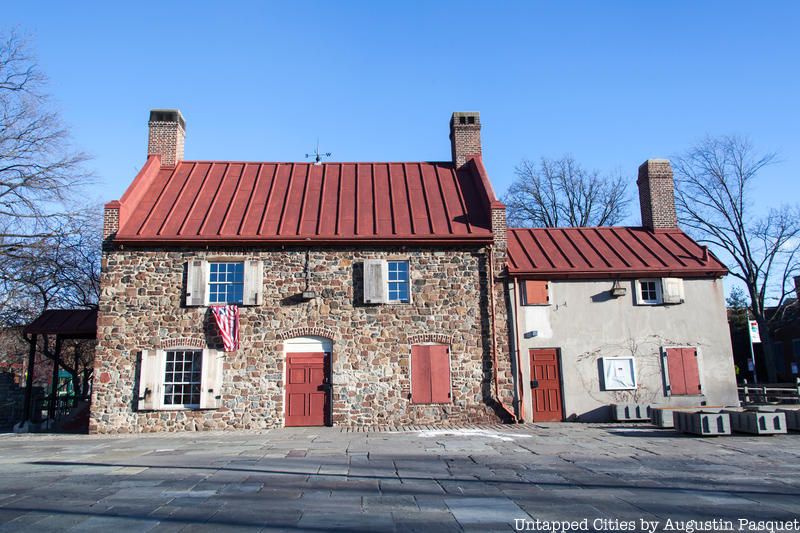
Near the Old Stone House in Park Slope, also known the Vechte-Cortelyou House, Lord Stirling was leading troops from Maryland, Delaware and Pennsylvania, which remained behind while George Washington and the main contingent of the army retreated.
The Old Stone House that sits in Park Slope today is not the original, nor the building used as a baseball and skating clubhouse for so many years (sometimes both in the lost sport of ice baseball). The original structure was demolished in the late 1890s and rebuilt in 1933, at a slightly different location using some of the original stones which had been unearthed in an excavation. Today it houses a museum operated by the Historic House Trust of New York City, showcasing exhibits on the house’s pivotal role in the Battle of Brooklyn and on Brooklyn culture, past and present.
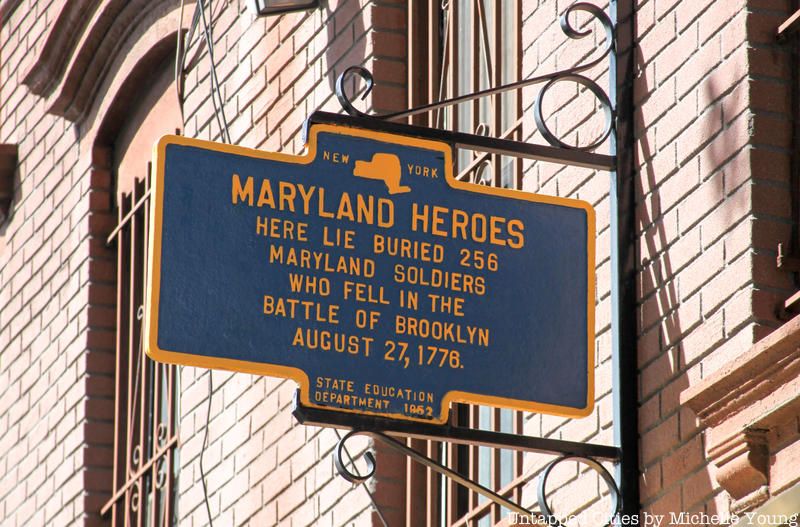
The sacrifice of the Maryland 400 during the Battle of Brooklyn is one of the most famous stories of the American Revolution. Facing heavy losses within the Pennsylvania and Delaware lines near the Old Stone House, Lord Stirling commanded those forces to retreat. The Maryland line, numbering under 500 young soldiers, volunteered to stay behind and create a diversion to hold back the 2,000 British troops under General Cornwallis who were pursuing the retreating Patriots.
The Maryland brigade rallied six times. Though defeated, they rallied long enough to enable Washington’s escape. 256 of the soldiers were killed and 100 taken hostage, including Lord Stirling. George Washington, viewing the carnage from Cobble Hill, was recorded to have exclaimed, “Good God! What brave fellows I must this day lose.” Without the efforts of the Maryland 400, it is thought that the American Revolution would have been lost after this single battle.
During this era, fallen soldiers were usually buried near where they were killed. The final burial place of the Maryland soldiers is still not officially determined and there is much debate surrounding the location. There is a plaque located at 429 Third Avenue to mark this spot, but based on topographical maps, archival letters and other contemporary research, it is believed that the location is incorrect. Archeologists, including Alyssa Loorya of Chrysalis Archeological Consultants have been working in tandem hoping to definitively locate the burial site.
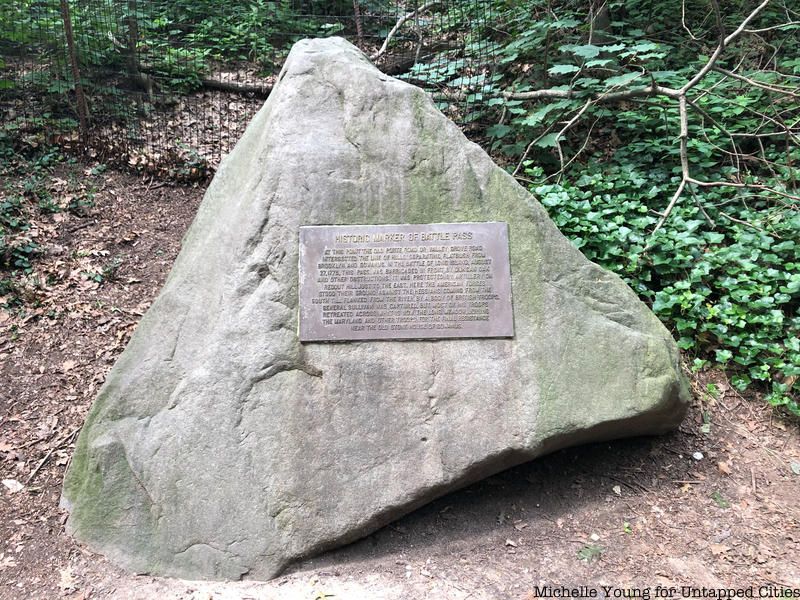
Along East Drive in Prospect Park, visitors will find a series of bronze plaques dedicated to American efforts during the battle. The location of the plaques denotes the line of defense the Americans put up along the ridgeline that extends from today’s Green-Wood Cemetery, through Prospect Park to Mount Prospect Park. One of the points of entry along this defense line was Flatbush Pass, a path between rugged hills on today’s East Drive. This spot is marked by a small rock on the ground on the west side of East Drive known as Battle Pass Rock. Dedicated in 1929, the plaque’s inscription says that it marks the spot where the old Porte Road or Valley Grove Road intersected with the line of hills separating Flatbush from Gowanus.
Other monuments inside Prospect Park to the Revolutionary War include the Dongan Oak Monument, a monument designed by Stanford White to the Maryland 400, and one for the Marquis de Lafayette, the French nobleman who brought over much-needed soldiers and leadership during the war.

Lord Stirling ordered New Yorkers to assist in the defense of the city “every other day,” with the help of their slaves. This directive was officially passed by the New York Provincial Congress, who then required those in Kings County (Brooklyn) to follow suit. An earthen wall built in Brooklyn started at the head of Gowanus Creek and stretched to Wallabout Bay (where the Brooklyn Navy Yard is today). As Joseph Alexiou writes in Gowanus: Brooklyn’s Curious Canal, “with several redoubts, it provided an inner layer of defense for Brooklyn,” with Fort Box protecting Gowanus.
Despite this defense, the Americans would lose the Battle of Brooklyn, of which much was fought on the edges of Gowanus Creek. The famous Patriot retreat involved crossing the Gowanus Creek. Many of the troops drowned or were shot in the crossing. Still Alexiou writes, “It is fair to call [the Gowanus Creek] an unsung hero of the Battle of Brooklyn—twice critical to the escape of Washington’s army. More than Battle Pass, honored by several plaques tucked away in Prospect Park, the Gowanus waters bore witness to that bloody day in history, as have generations of Brooklynites since.”
In the retreat from Brooklyn, American soldiers fled west from Prospect Park on the Porte Road downhill towards what was then the Gowanus swamp. In 2016, Nicholas Evans-Cato, a reader of Untapped Cities and professor at RSID who used to reside at 26 Garfield Place contacted us about a find he discovered checking out what had become of his former backyard. While 251 First Avenue was being constructed, a portion of the Porte Road where the soldiers traversed was visible.
Evans-Cato drew us a map which shows how a diagonal lot line at the rear of 12, 14 and 16 Garfield Place actually preserves the path of the original Porte Road. This map and the details were confirmed by Peter Joseph in 2011, a local historian and cartographer who is affiliated with the Old Stone House Museum, Evans-Cato says. Nonetheless he tells us, the topography has changed drastically here. What would have been the surface of the Porte and Gowanus Roads are now “way below the grade level.”
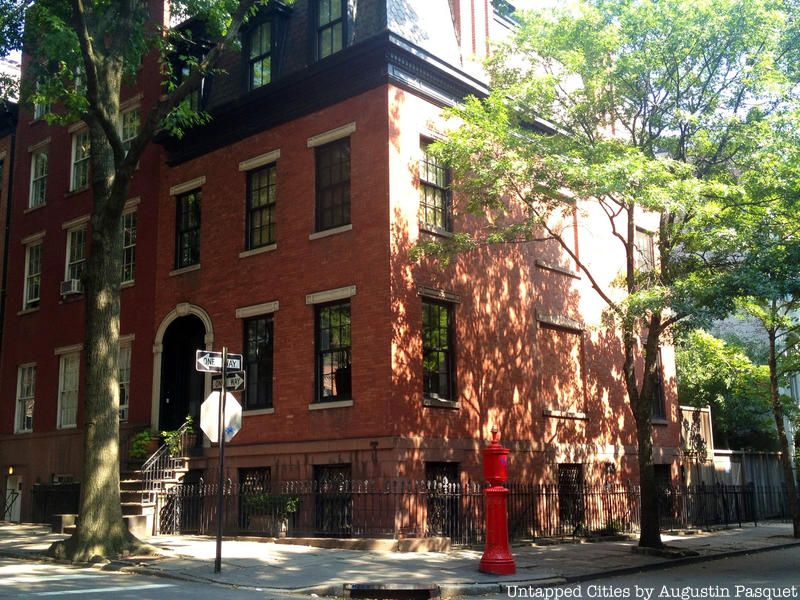
Brooklyn Heights was a pivotal location in the Revolutionary War, and in fact one of the names of this battle is the Battle of Brooklyn Heights. It is believed that General George Washington viewed the battle from Brooklyn Heights and he stayed at a house on Montague Street before leading the retreat back to Manhattan, aided by heavy fog.
Around this time, British forces confiscated the Livingston mansion in Brooklyn Heights to be used as a hospital and burial grounds. As a result, reports of Revolutionary-era, British bones being found in the backyards of Garden Place homes have circulated for years.
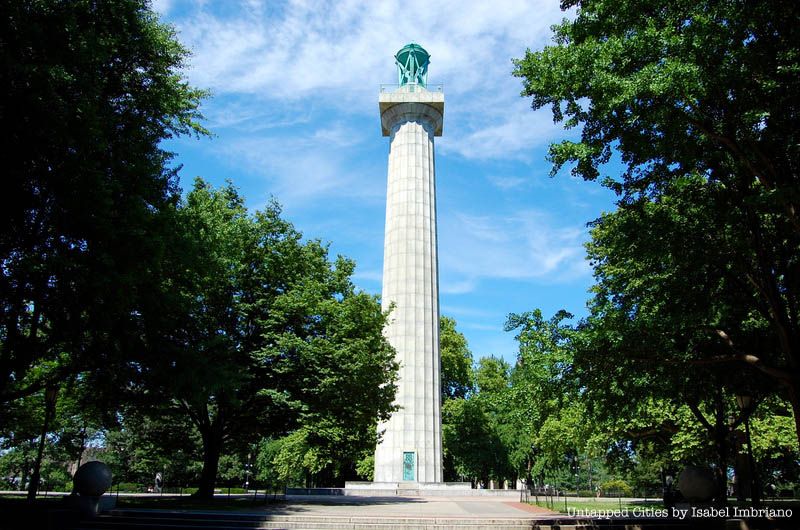
Fort Greene Park is named for one of the line of fortifications built west of Brooklyn Heights in preparation for the Revolutionary War. The fort, lone gone and replaced by the park, was star-shaped and originally known as Fort Putnam. According to the New York State Military Museum, each fort “was a complete entity surrounded with a wide ditch, sides lined with pointed stakes, and each had sally-ports. Most of the line also had abatises, field fortifications made of trees with sharpened tree tops facing the enemy.
In the center of Fort Greene Park sits the the Prison Ship Martyr’s Monument, a memorial and burial site designed by Stanford White to commemorate the Americans who died aboard British prison ships in New York harbor. The monument is rarely opened to the public, but we had the chance to document the inside in 2018.

In the midst of the street grid in Crown Heights is an odd diagonal midblock street known as Clove Road. Located behind an A&P supermarket, it’s so forgotten the Google Street View car didn’t even bother to turn down it. Yet, it may have one of the richest and longest histories of any street in the neighborhood.
Clove Road is what remains of a Native American trail and later Colonial era road and it retains some of its old Belgian blocks to boot. (Belgian block, rectangular pieces of granite that came from ship ballast, is commonly miswritten as cobblestone but the two are actually different.) Architect Michael Cetera, who has studied Clove Road in depth, says it was also an important location in the American Revolutionary War and was one of the first roads in Brooklyn to be paved. It was also possibly a portion of, or nearby, the Bedford Pass, which allowed passage through a ridge that is today’s Eastern Parkway. American troops used this pass to retreat back to Brooklyn Heights during the Battle of Brooklyn.
Originally published August 26, 2019
The name clove comes from the Dutch kleft, meaning a cleft between two hills that have since been flattened. Clove Road was originally much longer, running from present day Fulton Street to Empire Boulevard, after which it was known as Canarsie Avenue. As Kevin Walsh from Forgotten New York explains, Clove Road was likely intended to be eliminated when the new street grid was laid out but this section, between Montgomery Street and Empire Boulevard, somehow lingered on.
Subscribe to our newsletter